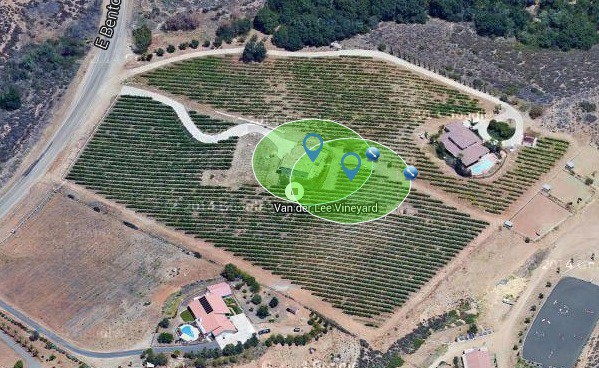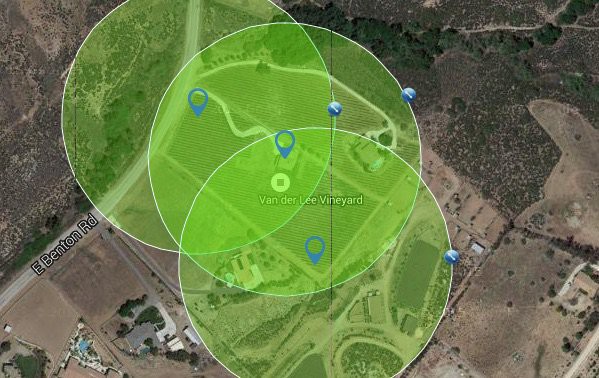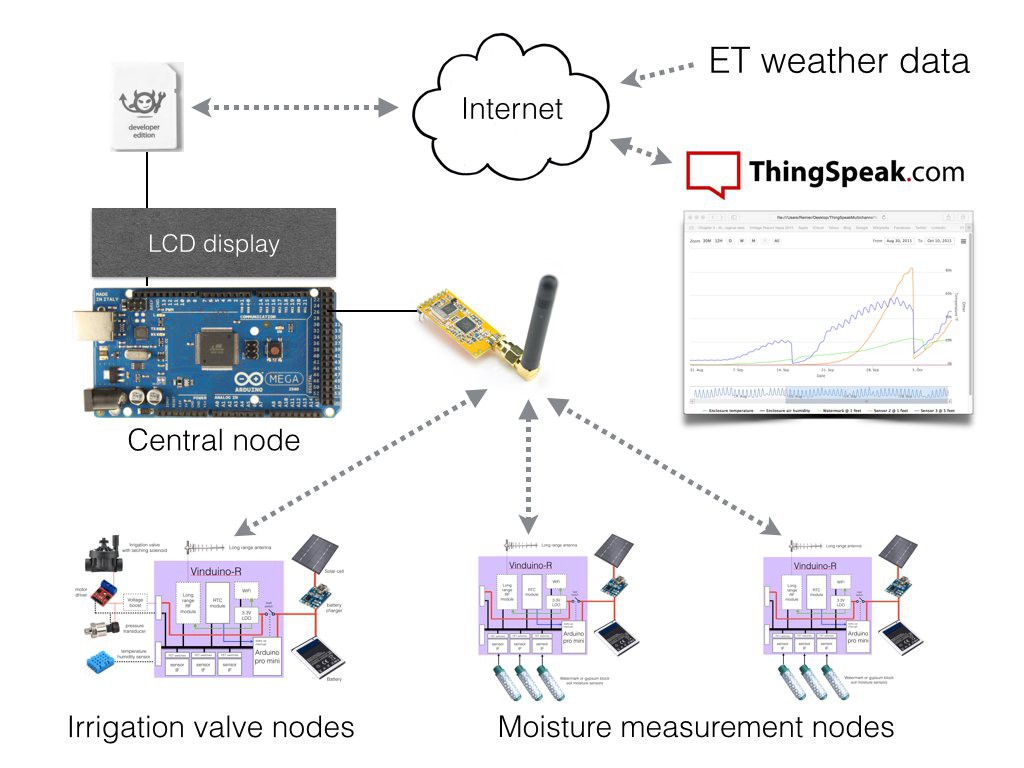Limited WiFi Range
The current Vinduino setup allows me to collect soil moisture data and send it to the ThingsSpeak website, where I can pull up graphs. As soil moisture changes slowly, having graphic capability is extremely helpful understanding the trends.
With the Highstock Java app, you can pull multiple data streams from ThingSpeak and display them together in one single window, definitely recommended if you have not seen it yet. http://forum.arduino.cc/index.php?action=dlattach;topic=213058.0;attach=66726
Next project phase is to increase the locations where I measure soil moisture, from 1 to 3, and replace the irrigation valve control timers by a node that allows me on-line control of the irrigation.
As the vineyard is in a rural area, Internet options are limited. I tried DSL, but that turned out way too slow and had incredible latency as well. Instead, I started using a WiFi hotspot. This works fine, but the range is limited to about 30 meters. Below picture shows the current situation. This setup does not allow full vineyard coverage.
Thanks Luke Beno for sharing this tool: http://www.freemaptools.com/radius-around-point.htm

Achieving full RF coverage
To get full coverage of the vineyard, I need at least 130 meter range for each node. That does not require "very long range" 915 MHz RF modules, but it's great to have the luxury of sufficient margin just in case. Output power of the Appcon modules can be set, and 20mW is probably sufficient. Below picture shows that a node range of 130 meters (300 feet) allows nodes in the extreme corners of the vineyard to reach the central node, located at the house. Of course, this is a small property in agricultural perspective, having the option of covering longer distance reliably is a hard requirement for agricultural use. The output power of the modules, and option of using directional antennas, allows for multiple miles of range if needed.

I chose not to use a mesh network. To keep power consumption low, the nodes wake up every 15 minutes by an RTC module interrupt. They connect to the central node, dump their data, and go back to sleep again. To avoid data collisions, the nodes need to listen before they transmit, and start a delay timer when the frequency is already used by another node.
Irrigation valve control node
With the RF connections taken care of, we can now look at the whole system to monitor and control irrigation water.
The Vinduino-R boards can be used for soil moisture monitoring (3 soil moisture sensors max), or can be used to control a DC latching irrigation valve. The unique property of a DC latching valve is that it stays locked open or close after driving it. That greatly reduces power, but there is a risk when the controller losses battery power that irrigation water keeps flowing forever........
The Vinduino board has two features to help mitigate that risk: monitoring of the battery voltage, and there is an input for a water pressure sensor. I typically measure 120 PSI before the valve, with a close irrigation valve, and around 30 PSI when the valve is opened. Pressure sensors are low cost (starting at $30) and are easy to use. They need 5V supply voltage, and the output scales linearly with pressure between 0.5V and 4.5V. Having water pressure feedback is a great way to check if valves are operating appropriately.

Determining irrigation time
Irrigation time is managed to replace the water that is used by the vines on a daily basis. The irrigation dripper need to be checked/calibrated so you know that a 1 gallon/hr dripper really does what it is supposed to do. Usually it takes adjusting the irrigation system to ensure homogeneous irrigation over the whole area. Once you have that done, you know the time it takes to replace a gallon of water.
The Vinduino system combines two variables to determine grapevine daily water use, and adjust irrigation times towards that. Using local ET (evapotranspiration) data from a local weather station, or use your own weather station to calculate that.
The state of California has developed a protocol to get daily localized ET data: http://www.bewaterwise.com/icp/IRWD.pdf
ET0, together with the "crop factor" (how much % of foliage covers the ground), can be used for a calculated estimate of the water use per grape vine.
The crop factor varies over the growing season, so the estimate has quite some error-margin. By including soil moisture trend to the irrigation time estimate, we can optimize the irrigation time to really match the grape vine water consumption.
Assuming the goal is to keep moisture constant (replacing vine water use), an increasing soil moisture indicated overshooting the needed irrigation time, etc..... Of course, we measure in the root zone, and avoid drainage below the root zone.
The Vinduino project started a collaboration with Luke Beno's analog.io - A full stack IoT platform for the further development of the back-end service and user interface. As a first result, I am now looking at using the Electric Imp for Internet connectivity and pulling in ET data.
 Reinier van der Lee
Reinier van der Lee
Discussions
Become a Hackaday.io Member
Create an account to leave a comment. Already have an account? Log In.
Thanks for the mention, I'm happy to help. I posted this page to help you retrieve the ETo date using the Electric Imp: https://hackaday.io/page/1281-how-to-get-ca-eto-date-with-electric-imp
When the time is right, I can also advise a data exchange method between the Arduino and Electric Imp. It is the same thing that I'm using in this Wireless Hub Node: https://hackaday.io/project/4648-analogio-a-full-stack-iot-platform/log/26406-24ghz-to-915mhz-bridge
Are you sure? yes | no